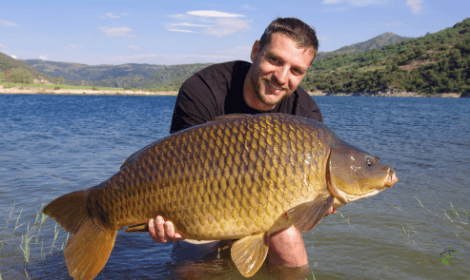
Carp fishing can be a top-class hobby with lots of ways to catch these fish. Depending on your preferences, you can go from targeting smaller fish to the biggest in specific venues – as you wish by altering your approach.
If you love catching giant carp, then “specimen” carp fishing is for you. Never heard of it before? Fret not – you’re at the right place.
This blog post is for beginners looking to learn about specimen carp angling, and there might even be some value for experienced specimen carp anglers out there. This post will teach you:
- What is specimen carp fishing;
- How it compares with other fishing methods;
- What gear you should use when fishing for specimen carp;
- And what are some common approaches to specimen carp fishing?
Without further ado, let’s get into it!
What is Specimen Carp Fishing
Experienced anglers already know what specimen carp fishing is, but beginners may not. I can’t start by discussing specimen carp fishing particulars without first talking about what it is. Right? To put it simply, for beginners, Specimen carp fishing is a carp fishing method and approach. Seems obvious?
Specimen carp fishing is different from regular angling. It’s more like catching big or specific “specimen” fish rather than many fish. In this case, the target is to catch carp. Besides, specimen anglers use larger baits, heavier gear, and commonly fish for more extended periods.
Yes, it is common for specimen carp anglers to stay in an area for an extended period in the hope of catching a record size fish. Some anglers see big fish as trophies and proudly take photos of themselves with their catch.
So, when did anglers discover this method? What was the need? Back in the day, anglers were using old conventional angling that aimed at catching large amounts of fish, and the quantity of fish was considered a better result over quality of fish. But what if someone wants to catch a big fish?
Let’s be honest; the old method has worked for many anglers in the past for so many years; the fish’s size was always the problem. Anglers spent hours catching small and medium sized fish but very few were fortunate enough to catch huge carp.
That’s when anglers developed specimen carp fishing and moved from quantity to quality. This fishing style uses European tactics to target massive fish. To some of you, this fishing style might sound daunting or even out of reach.
But trust me, it’s a method that will help you help you become a more conscious angler in every sense once you learn.
In case you are thinking of starting specimen carp fishing, I have a list of essentials that you will need for this fishing style:
- Rod pod
- Reels
- Rigs
- Rods and bank sticks
- Bite Indicators
- Bite alarms
- Terminal tackle
- Bait
- Camping Equipment
- Tacklebox
- Landing net
- Unhooking mat
- Spod / bait rocket
Specimen vs. Match vs. Commercial Fishing
Specimen, match, or commercial fishing? There is a considerable difference between these three. In simpler words, if big fish are your attraction and quality is your first preference, then you are into specimen fishing.
On the contrary, if you like competition and the challenge of catching as many fish as possible, you will prefer match fishing. Let’s look at these more in-depth.
Specimen Fishing
- Time duration – Unlike match or commercial carp fishing, it is common for anglers to fish for days without even a bite. The time spent fishing for one bite is far longer than commercial or match angling.
- The more time spent on the bank, the more chance serious specimen carp anglers will have to catch the targeted fish.
- Type of gear – Specimen carp fishing requires different equipment to target the large fish, making it unique from the others.
- Carp care gear – As anglers wish to catch the biggest fish, you should have the right equipment to accommodate the carp.
- The best care must be provided to these large specimen fish when they are on the bank.
Why is it so essential to consider carp care gear? – Usually, specimen fish are the primary breeding stock of the water they are located in. Like other anglers, your top priority should be fish health, and for that, you need standard care.
Match Fishing
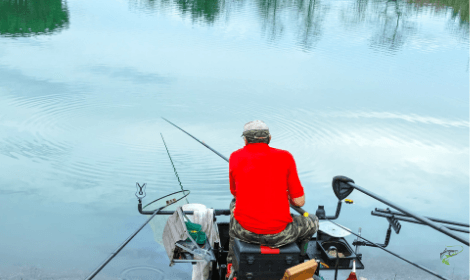
Some anglers like to challenge other anglers and want to see how good they are at catching fish within a time limit. A match is organized, mainly for commercial fishers at different venues to enhance the various skills and strategic minds.
This match aims at exploring how beautifully and efficiently fishers can plan, change their ideas and tactics according to the given situation, including the atmosphere, temperature, etc.
Anglers usually take large amounts of equipment like bait, bait stand, bucket, seat box, feeder, trolley, etc. This equipment gives them the biggest variation of bait to adapt to changing conditions and find what’s working on a specific day to catch as many fish as possible.
Commercial Fishing
Are you a weekend angler who enjoys spending a few hours on the banks to pass some time? Then your style of fishing is classed as commercial fishing.
It is common for anglers to catch many fish of various sizes at well-stocked commercial waters. The main difference is the lack of time constraints and rules, with most commercial anglers happy to catch any size of fish.
The equipment for commercial fishing is similar to specimen fishing but on a lighter scale.
Moreover, for commercial carp fishing, mainly two methods are used: float rigs and feeder rigs.
By now, you know what specimen carp fishing is and how it is different from other fishing styles.
What Is Considered a “Specimen Fish”?
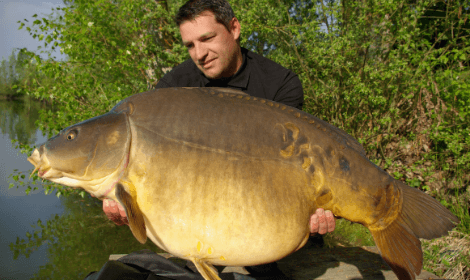
Though there really aren’t any hard rules in my opinion on the requirements for a fish to be a specimen fish. Some fish are just unique, and an angler might want to catch it for that reason alone, in spite of the size.
In North America for example, mirror carp can be exceptionally rare in many areas, this alone is enough for the carp to be a specimen fish, whereas in the U.K. a mirror carp is far more common relatively speaking.
Other attributes could be as simple as a bulged eye, scars, weird scale patterns, some sort of anatomical defect in places like the tail, you name it. Specimen fish is in the eye of the beholder, just as much as one angler might consider a particular sized fish a trophy fish to them, but other anglers wouldn’t.
Plus, people like to play it as a sport. By chasing after these distinct and unique fish across multiple venues, your fishing will take on far more purpose, which can add to the excitement.
Specimen fish in the UK is commonly mirror carp
or common carp, but it’s not unheard of for specimen koi carp
or even grass carp to be swimming in certain waters.
Unlike other gear, specimen fishing style gear is slightly different – let’s have a look.
Is Specimen Carp Gear Different?
If your specimen fishing in order to catch fish of large size calibre, the gear you need to use should be a bit beefier than conventional carp fishing tackle.
Larger and stronger rods would be a great consideration if you intend to target trophy-class fish only, as well as stronger line considerations, larger hooks, and an increase in hook bait size in many instances.
If you’re an avid carp angler you will like already have gear related to fish health and proper handling and releasing equipment. If not, be sure to invest in a high-quality carp mat, carp sack, and large landing net.
You may already have the gear needed for specimen carp fishing, and for many anglers that is the case, as specimen carp aren’t any different in terms of gear needed, it just needs to be able to handle larger fish.
Line
You should choose the line by keeping these things in mind, like the fish’s weight and venue composition. These two things determine the line strength for your carp fishing; also, the chosen line should be monofilament.
Reel
Select a big pit reel that will give you enough line to cast heavy baits large distances.
Fishing Rod
What if your rod is not strong enough? Then you run the risk of losing specimen fish once they are hooked. A high test curve rod is recommended to ensure you have plenty of control over the fish.
Alarms and Pods
You probably don’t want to miss the chance to catch the fish? If so, then another piece of equipment essential to have is a rod pod.
Rod pods are handy during night time as they can wake you up anytime when they detect any takes or even line bites. This equipment is so efficient that you must have it to miss chances to catch a fish.
Camping Gear
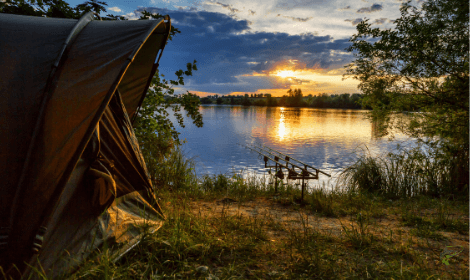
It is not mandatory to go camping; it’s up to you whether you want to do it or not. Some anglers prefer it for their own experience, especially when they are with their families or friends.
It is common to camp and fish overnight when specimen fishing. In some venues, the feeding activity at dusk, dawn, and sometimes through the night increases, which could be where you hook into that monster specimen.
Understanding the Specimen Carp Approach
To be a successful carp angler, make a habit of always thinking new strategies or bringing old ideas to continue fooling the giant carp. Let’s discuss some common specimen carp approaches or carp angler’s priorities.
Select the Best Location
So where do you even begin when it comes to specimen fishing? A good place to start is to simply spend time on the waters, you fish, and scout.
Scouting is one of the most critical aspects of specimen fishing, and without it, you simply can’t fish for a specific fish. Scouting means that you as an angler have to dedicate more time on the water than the casual angler.
Scouting means time, the more time you spend scouting the more opportunities you have to find a specific carp you want to catch based on size or some other unique attribute as mentioned earlier.
There is a saying that says; Put the location first, then apply a simple but effective rig.
On arriving at the venue, your first task should be to locate the carp because most anglers’ location is the be-all and end-all. Here are a few key points to find big carp.
One of the most important of all is to be at the lake for the first light. Arriving early, just before the sunlight, will dramatically increase your chances of seeing fish. The hours surrounding the sunrise is the time when carp commonly show themselves and actively feed most.
Carp also show themselves during the day; in fact, they show at any time of the day, and all shows are worth taking note of. The thing to remember is that showing carp represents one thing: it might not be a feeding carp but indicating that they are definitely in the area.
Unfortunately, sometimes you might have to spend hours or even days searching for carp and not seeing any. If that is the case, then use the already available information. Look for the areas where carp frequently visit, such as snags, Islands, gravel bars, or reed beds.
Key: Use all signs that are relevant to build a bigger picture.
You Found some Fish, Now What?
Scouting is half the battle, once you have found some target fish you want to catch, you have to pursue them, and keep tabs on them on a regular basis. Again, this goes back to the point mentioned earlier that specimen fishing typically requires a good portion of your free time.
Most of the time, carp will stay in a given area, let’s call it a home range. This means that you will likely see this fish on a regular basis if the conditions are right, but if you go long periods of time without seeing it, the fish may have moved, but most likely it is still somewhere near the area you frequently saw the fish in.
Now it’s time to start actually fishing for it, and as you encounter it you may get clues to help you with your cause.
You may be able to see how the fish reacts to certain baits and rig presentations, this will allow you to tailor a specific presentation over time to get the fish to bite.
Many carp targeted by specimen anglers are large, old, and wise carp that have seen every trick in the book, and this is the reason why these anglers enjoy specimen fishing, it’s a true battle of wits and the thrill of the chase is just as exciting as the catch.
Pre-baiting
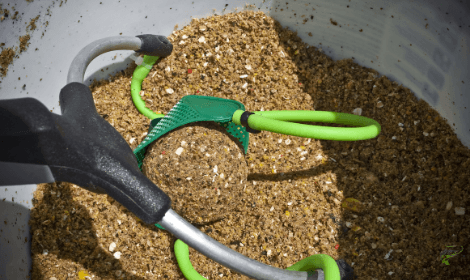
Pre baiting is an effective technique to help catch many carp. Though it’s an older fishing tactic and involves a lot of hard work, it can yield some gratifying catch results, I believe!
Before starting first, select a spot where you know carp frequently visit to make it more effective instead of throwing a massive amount of bait into easy or accessible swim.
For busy lakes, it’s better to pre-bait at night, if possible. Also, I would recommend you pre-baiting 2-3 times or even a week before you intend to fish. Visiting the lake regularly will get carp to associate your bait as a safe food source and get a chance to see if a fish are present or the bait has been eaten.
Furthermore, pre-baiting a few separate times will allow you to identify any fish movement around the areas you put the bait. You will get the chance to see if any other angler caught any fish near your intended spot or region.
Rigs
When targeting big fish, you need strong, reliable material. Chod rig or stiff link rigs are commonly used to catch big carp.
Words of Wisdom
If you are friends with many of the other anglers in your area, it’s wise to do one thing with this style of fishing, keep your mouth shut.
If you find some absolute brutes swimming in an area don’t tell anyone! Not even your buddies. Even if your buddies have good intentions, all it takes is talking to the wrong person at the pub and your secrets are out.
This might sound rude to keep this a secret, but look at it this way, you spent a large amount of time and effort studying your water and finding these fish, and even longer trying to catch them, that information is valuable for this very reason, so don’t let everyone know what you discover, or it won’t be there the next time you go out to catch that giant.
Final Thoughts
Now you should have a good understanding of what specimen carp angling is. It is different than other conventional methods in many ways, such as time spent in fishing, gear, approach, etc.
Indeed it is a whole new world of information to learn, but it’s a fun sport. If you have any experiences with specimen carp angling or any questions please feel free to leave a comment below.

